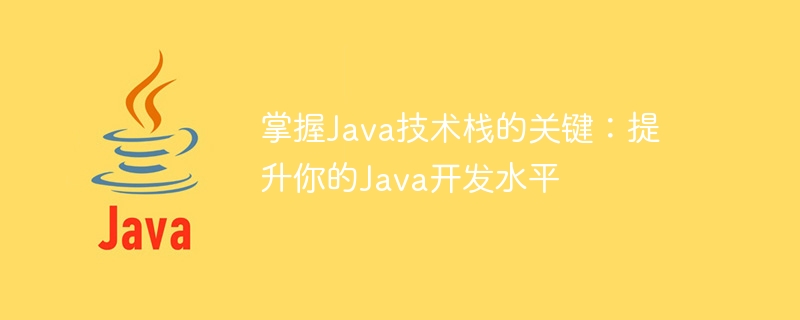Home >Java >javaTutorial >The key to improving Java development level: Mastering the Java technology stack
The key to improving Java development level: Mastering the Java technology stack
- WBOYWBOYWBOYWBOYWBOYWBOYWBOYWBOYWBOYWBOYWBOYWBOYWBOriginal
- 2024-01-09 19:41:19617browse

The key to mastering the Java technology stack: To improve your Java development level, you need specific code examples
As a programming language widely used in software development, Java A large number of application scenarios and powerful functions make people more and more obsessed with it. However, while pursuing efficient development, you must also pay attention to improving your Java development level in order to stand out in the fierce competition. This article will introduce some key technology stacks and help you improve your Java development level through specific code examples.
1. In-depth understanding of Java core technology
1.1 Multi-threaded programming
Multi-threading is a very important feature in Java, which can improve the performance and efficiency of the program. Before mastering multi-threaded programming, we need to understand the basic concepts and principles of threads. The following is a simple sample code:
public class MyRunnable implements Runnable {
public void run() {
for (int i = 0; i < 10; i++) {
System.out.println(Thread.currentThread().getName() + ": " + i);
}
}
}
public class Main {
public static void main(String[] args) {
MyRunnable myRunnable = new MyRunnable();
Thread t1 = new Thread(myRunnable);
Thread t2 = new Thread(myRunnable);
t1.start();
t2.start();
}
}1.2 Java IO and NIO
Java IO and NIO are APIs used to process input and output in Java. Java IO is a stream-oriented operation, while Java NIO is a block-oriented operation with higher performance and efficiency. The following is a simple sample code for reading a file:
public class Main {
public static void main(String[] args) {
try {
FileInputStream fileInputStream = new FileInputStream("file.txt");
InputStreamReader inputStreamReader = new InputStreamReader(fileInputStream);
BufferedReader bufferedReader = new BufferedReader(inputStreamReader);
String line;
while ((line = bufferedReader.readLine()) != null) {
System.out.println(line);
}
bufferedReader.close();
inputStreamReader.close();
fileInputStream.close();
} catch (IOException e) {
e.printStackTrace();
}
}
}2. Java Framework
2.1 Spring Framework
Spring framework is a lightweight open source framework that provides Provides comprehensive enterprise-level application development support. The following is a simple sample code for dependency injection using the Spring framework:
public class Main {
private UserService userService;
public void setUserService(UserService userService) {
this.userService = userService;
}
public void run() {
String username = "John";
User user = userService.getUserByUsername(username);
System.out.println(user);
}
public static void main(String[] args) {
ApplicationContext context = new ClassPathXmlApplicationContext("applicationContext.xml");
Main main = (Main) context.getBean("main");
main.run();
}
}2.2 Hibernate framework
Hibernate is an open source object-relational mapping framework used to simplify database operations. The following is a simple sample code using the Hibernate framework for data persistence:
@Entity
@Table(name = "user")
public class User {
@Id
@GeneratedValue(strategy = GenerationType.IDENTITY)
private int id;
@Column(name = "username")
private String username;
@Column(name = "password")
private String password;
// Getters and setters
}
public class Main {
public static void main(String[] args) {
SessionFactory sessionFactory = new Configuration().configure().buildSessionFactory();
Session session = sessionFactory.openSession();
Transaction transaction = session.beginTransaction();
User user = new User();
user.setUsername("John");
user.setPassword("123456");
session.save(user);
transaction.commit();
session.close();
sessionFactory.close();
}
}3. Java development tools
3.1 Maven
Maven is a powerful project management tool , can help developers build, test and deploy Java projects efficiently. The following is a simple sample code for using Maven to build a project:
<project>
<modelVersion>4.0.0</modelVersion>
<groupId>com.example</groupId>
<artifactId>my-project</artifactId>
<version>1.0.0</version>
<dependencies>
<dependency>
<groupId>com.example</groupId>
<artifactId>my-library</artifactId>
<version>1.0.0</version>
</dependency>
</dependencies>
</project>3.2 Git
Git is a distributed version control system that can effectively manage and track code changes. The following is a simple example code for using Git for code management:
git init git add . git commit -m "Initial commit" git branch new-feature git checkout new-feature
By mastering the above key Java technology stack, we can improve our Java development level and better cope with complex business needs and project implementation . In the process of learning, practice more code examples and focus on the accumulation of open source communities and books. I believe you will make greater breakthroughs and contributions in the field of Java development.
The above is the detailed content of The key to improving Java development level: Mastering the Java technology stack. For more information, please follow other related articles on the PHP Chinese website!
Related articles
See more- What front-end technologies do you need to learn for Java development?
- What are the four commonly used frameworks for java development?
- How to deal with inter-thread communication issues in Java development
- What does java technology stack mean?
- Understand the definition and application of Java technology stack

